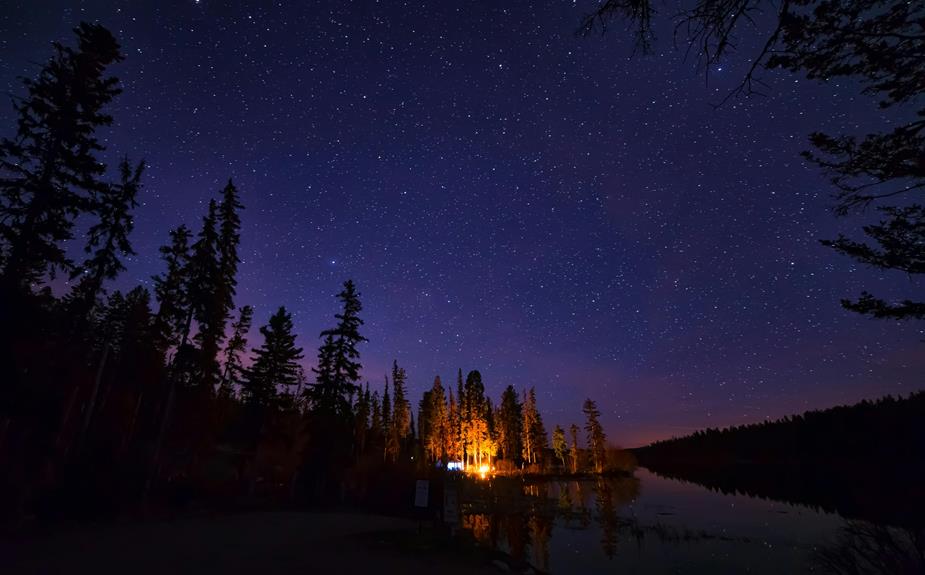
When camping in the wilderness, choose your campsite carefully by prioritizing minimal impact and opting for established areas. Use designated fire rings, keep fires small, and only use sticks from the ground. Pack out all trash and bury waste properly, away from water sources. Respect wildlife by observing from a safe distance and not feeding them. Remember, there are more tips for leaving no trace and protecting nature.
Choosing the Right Campsite
When selecting a campsite in the wilderness, prioritize minimizing your impact on the environment by choosing a location that's already well-established. Opt for designated campsites or areas that show signs of frequent use, like clearings or existing fire rings. By setting up your camp in these established spots, you help protect fragile ecosystems and prevent further damage to the surrounding flora and fauna.
Avoid creating new campsites or trampling on vegetation to set up your tent. Look for areas with durable surfaces such as rock, gravel, or dry grass to pitch your shelter. This simple choice can significantly reduce your environmental footprint and preserve the natural beauty of the wilderness for future generations to enjoy.
In addition to choosing a well-established campsite, consider its proximity to water sources. Select a spot that's at least 200 feet away from lakes, rivers, or streams to prevent water pollution and protect aquatic habitats. By making thoughtful decisions when picking your campsite, you can ensure a more sustainable and low-impact camping experience in the great outdoors.
Minimizing Campfire Impact
To minimize your impact while camping, practice responsible campfire etiquette by following Leave No Trace principles. When building a campfire, opt for established fire rings or fire pans whenever possible. If these aren't available, choose a spot at least 200 feet away from water sources to prevent contamination and follow any specific rules or guidelines set by the area you're camping in.
Keep your campfire small and only use sticks found on the ground for fuel. Avoid breaking branches off trees or cutting down live vegetation. Make sure to completely extinguish your campfire before leaving the site or going to sleep. Stir the ashes and pour water over them, feeling for any remaining heat to ensure the fire is out. Once the ashes are cool to the touch, scatter them over a wide area away from your campsite.
Proper Waste Disposal
Properly disposing of waste is crucial to maintaining the cleanliness and natural beauty of the wilderness. When camping, always follow the principles of Leave No Trace to ensure you aren't leaving a negative impact on the environment. One of the most important rules is to pack out all your trash. This means bringing back everything you brought into the wilderness, including food wrappers, leftover food scraps, and any other waste.
For human waste, make sure to dig a hole at least 200 feet away from any water source, campsites, or trails. Bury the waste at least 6 to 8 inches deep and cover it properly. Never leave toilet paper or hygiene products on the ground; either pack them out or bury them along with the waste.
Respecting Wildlife
Respect wildlife by observing from a safe distance and refraining from feeding or approaching them. When camping in the wilderness, it's crucial to remember that wildlife should be appreciated from afar to ensure both their safety and yours. Approaching or feeding wild animals can disrupt their natural behavior, create dependency on humans for food, and even pose risks to your own safety.
Maintain a respectful distance when encountering wildlife to avoid causing unnecessary stress or harm. Use binoculars or cameras with zoom lenses to observe animals up close without intruding on their space. Remember that these creatures are best admired in their natural habitat, free from human interference.
Additionally, resist the temptation to feed wildlife, as it can lead to habituation and alter their foraging habits. Human food may also be harmful to animals and attract them to campsites, increasing the likelihood of negative encounters. By respecting wildlife boundaries and refraining from feeding or approaching them, you contribute to the preservation of their natural behaviors and ecosystems.
Conclusion
Remember, leaving no trace when camping in the wilderness is essential to preserving the beauty of nature for future generations.
By choosing the right campsite, minimizing campfire impact, properly disposing of waste, and respecting wildlife, you can ensure that your outdoor adventures have minimal impact on the environment.
Take pride in leaving nature as you found it, or even better, and enjoy the peace and tranquility of the great outdoors without leaving a trace behind.




